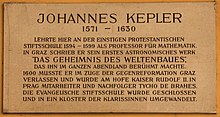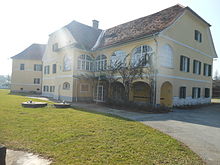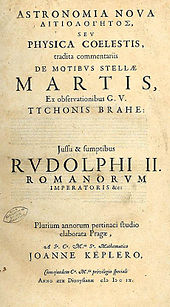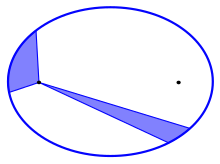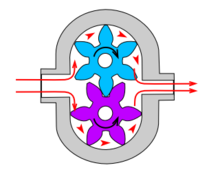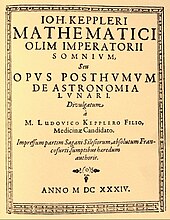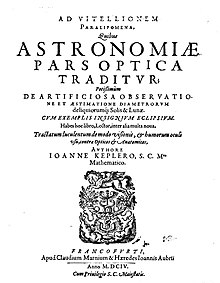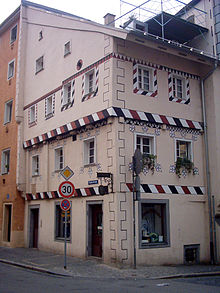Johannes Kepler
Johannes Kepler (also Keppler and Johann Kepler , Latinized Ioannes or John Keplerus * 27. December 1571 jul. In Weil der Stadt , † 15. November 1630 greg. In Regensburg ) was a German astronomer , physicist , mathematician and natural philosopher .
From 1594 to 1600 Kepler was a landscape mathematician in Graz , that is, a mathematician of the state of Styria . He taught mathematics at the Protestant collegiate school. From March 1600 there was a difficult collaboration between Kepler and Tycho Brahe in Prague until he died in October 1601, whereupon Kepler arranged his estate. Then Kepler became an imperial mathematician and held this position until 1627. From 1612 to 1626 he also worked as a landscape mathematician in Linz . During the Thirty Years' War , Kepler wrote horoscopes for the commander-in-chief of the imperial army, Generalissimo Wallenstein , in which difficulties were predicted for the generalissimo in 1634, the year of his death.
Johannes Kepler discovered the laws according to which planets move around the sun . They are called Kepler's laws after him . He made optics the subject of scientific investigation and confirmed the discoveries that his contemporary Galileo Galilei had made with the telescope . Kepler is one of the founders of modern natural sciences. With his introduction to calculating with logarithms , Kepler contributed to the spread of this type of calculation . In mathematics, a numerical method for calculating integrals was named Kepler's barrel rule after him.
His discovery of the three planetary laws turned the medieval worldview , in which disembodied beings kept the planets, including the sun, in constant motion, into a dynamic system in which the sun actively influences the planets through action at a distance. He himself, however, never called them “laws”; in his eyes they were rather an expression of the harmony of the world which the Creator had given his work. From his point of view, it was also divine providence that led the theology students to study the stars. The natural world was to him a mirror in which the divine ideas could become visible, the god-created human spirit there to recognize and praise them.
Kepler went beyond the idea that the Copernican system was merely a ( hypothetical ) model to simplify the calculation of the planetary positions. The heliocentric world view to be seen as a physical fact, encountered not only in the Catholic Church , but also in Kepler's Protestant superiors fierce resistance. Because in both denominations the teachings of Aristotle and Ptolemy were considered inviolable.
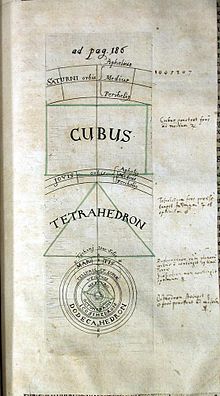
The fact that Kepler also represented a holistic philosophy highlights, among other things. the historian Volker Bialas emerged. For Kepler, as a theologically educated astronomer, one of the main motifs of his work was to be a “priest of the book of nature”, and he expressed himself several times in a conciliatory manner on questions of faith and the disputes during the Reformation .
Life
Childhood and Education (1571 to 1594)
Johannes or Johann Kepler was born on December 27, 1571 in the free imperial city of Weil der Stadt . Today it is part of the greater Stuttgart area and is located 30 kilometers west of Stuttgart city center. Kepler's grandfather Sebald Kepler (1519–1596) was mayor of this city, married to Catharina Müller. At the time of Johannes Kepler's birth, the family was in economic decline. His father, Heinrich Kepler, earned an uncertain livelihood as a trader and left the family several times to serve as a mercenary abroad . His mother Katharina , daughter of an innkeeper, was a herb woman and was later accused of witchcraft . Kepler lived with his parents in Ellmendingen from 1579 to 1584 , where his father leased the “Sonne” inn.
As a premature birth , Johannes was always referred to as a weak and sick child. In 1575 he survived smallpox , which, however, permanently impaired his eyesight. Despite his poor health, he was precocious and often impressed travelers at his mother's inn with his math skills. Kepler's mother aroused his interest in astronomy at an early age . She showed him the comet of 1577 and the lunar eclipse of 1580.
Kepler attended the first class of the Latin school in Leonberg and the second class of the Latin school in Ellmendingen. In 1580 and 1581 he had to interrupt school education. In 1582 he attended the third grade of the Latin school, "because otherwise he is no good". From 1584 (October 16), Kepler attended the monastery school in Adelberg , from 1586 (November 26) after passing the state examination, the higher Protestant monastery school (grammar school) in the former Maulbronn monastery .
After receiving a scholarship, he began to study theology at the Evangelical Monastery in Tübingen in 1589, despite modest family circumstances . He studied with the mathematician and astronomer Michael Maestlin , saw himself as an outstanding mathematician and earned the reputation of a skilled astrologer . Under the guidance of Michael Mästlin he got to know the heliocentric system of planetary movements of Nicolaus Copernicus . He became a Copernican and defended the Copernican view of the world from both a theoretical and a theological point of view in student debates. During his studies he became friends with the lawyer Christoph Besold . On August 11, 1591 he was awarded a master's degree .
Kepler in Graz (1594 to 1600)
Kepler originally wanted to be a Protestant clergyman. In 1594, however, at the age of 23, he accepted a teaching assignment for mathematics at the Protestant collegiate school in Graz. This college was the Protestant counterpart to the university , which was run by Jesuits and was the engine of the Counter Reformation . In Graz, Kepler began to work out a cosmological theory based on the Copernican view of the world. At the end of 1596 he published it as Mysterium Cosmographicum.
In December 1595, Kepler met 23-year-old Barbara Müller, who was already widowed twice and had a daughter. The fortunes inherited from their husbands made them a good match. When Kepler wooed her, her father, a wealthy miller, initially refused to marry what he saw as a poor Kepler and almost broke the relationship. He finally gave in when representatives of the Church put pressure on him to recognize Kepler as a son-in-law. Kepler and Barbara Müller married in April 1597. The couple had five children. A son and a daughter (Heinrich and Susanna) did not survive their childhood days. Then came the children Susanna (* 1602), Friedrich (* 1604) and Ludwig (* 1607).
In the 1590s, Kepler wrote letters to Galileo Galilei , who only replied in detail once. In December 1599, Tycho Brahe invited Kepler to work with him in Prague . Forced to leave Graz by the Counter Reformation, Kepler met Brahe in 1600.
Imperial court mathematician in Prague (1600 to 1612)
In 1600 Kepler took a position as assistant to Tycho Brahe . The collaboration between the two scientists in Prague and at Benatek Castle was not easy, although their different talents complemented each other. Brahe was an excellent observer , but his math skills were limited. The outstanding mathematician Kepler, on the other hand, was barely able to make precise observations because of his ametropia . Brahe feared, however, that with his extensive life's work, the records of astronomical observations of the planetary orbits and hundreds of stars, Kepler's fame could be justified. In addition, Brahe only rudimentarily shared the astronomical views of Kepler (and Copernicus).
After Brahe's death in 1601, Kepler became the imperial court mathematician . He held this post during the reign of the three Habsburg emperors Rudolf II , Matthias I and Ferdinand II . As the imperial court mathematician, Kepler took on responsibility for the imperial horoscopes and the task of drawing up the Rudolfinian tables .
In October 1604, Kepler observed a supernova that was later named Kepler's star . In the same year, like Cardano in 1570, Kepler presented scientific figures on the pulse rate and specified his observations in 1618 (so the normal pulse rate is 70, for old or melancholy people 60, for choleric people and women 80 beats per minute).
By working with Brahe's extensive collection of very accurate observational data, Kepler wanted to improve on his earlier theories, but had to discard them in view of the measurement data. He then began to design a new astronomical system. Based on the Copernican system, he determined the actual planetary orbits for the first time without specifying from the outset that they had to be a combination of uniformly traversed circular orbits. After a long search he identified the relatively eccentric orbit of Mars as an ellipse . He then determined how the orbital velocity of the planet varied along the orbit. He completed this work in 1606 and published it in 1609 as Astronomia nova. The book contained Kepler's first and second laws .
In 1611 Kepler published a monograph on the origin of the snowflake , the first known work on the subject. He correctly suspected that its hexagonal shape was due to the cold, but could not yet justify it physically. In 1611, Kepler also published a paper on dioptrics and what was later known as the Kepler telescope .
1611 became a fateful year in Kepler's life. In January his three children fell ill with smallpox and their six-year-old son Friedrich died. To escape the growing religious and political tensions, Kepler looked for a new job. An application to become a professor at the University of Tübingen was rejected in April. In June Kepler's application in Linz was successful, where he was promised the post of Upper Austrian provincial mathematician ( land surveyor ). Shortly after Kepler returned to Prague, his wife Barbara died. Rudolf II had meanwhile been deposed as King of Bohemia by his younger brother Matthias and now ruled as emperor without a country. He asked Kepler to stay in Prague, and Kepler postponed his move.
Kepler in Linz (1612 to 1627)
Rudolf II died in January 1612. Kepler moved to Linz in April and took up the position as a mathematician in Linz, which he kept until 1626. After losing his first wife, he had considered a total of eleven candidates as a second wife over the course of two years. Finally, in October 1613, he married the Eferding citizen daughter Susanne Reuttinger. Of the six children they had, the three first born died early; a daughter (* 1621) and two sons (* 1623 and * 1625) survived their childhood. In 1612/13 Kepler lived outside the city walls "in the vineyard" , presumably in today's Kapuzinerstraße 18, and from 1613 to 1620 in Hofgasse 7, where a memorial plaque was placed in 2018. Kepler's third house in Linz (1622 to 1626) is located at Rathausgasse 5 and is used as an educational center under the name Kepler Salon .
From 1615 on he had to take care of the defense of his mother Katharina , who was accused of witchcraft . Associated with this was a lengthy lawsuit for compensation for a poisonous drink allegedly passed on by her, which was in connection with a previous business dispute. Several women had already been burned as witches on site and she herself was directly threatened by a similar fate. Also to the annoyance of the local judiciary, Kepler was very committed to his mother and obtained her release in October 1621. He was helped by a legal opinion from the University of Tübingen, which probably goes back to his college friend Christoph Besold . Kepler's mother died six months later, presumably as a result of her imprisonment, in which she was chained for 14 months and threatened with torture.
Problems increased in Linz. Kepler found it difficult to collect his money claims. His library was temporarily confiscated and his children were forced to attend the Catholic mass. His teaching was increasingly ostracized by the Protestant side. Theologians at his home university in Tübingen attacked him violently. Opposite Daniel Hitzler, the Lutheran country preacher in Linz, Kepler was critical of certain articles of faith. When Hitzler then demanded written consent from Kepler to the concord formula and Kepler refused for reasons of conscience, Hitzler excluded him from participating in Holy Communion. The family fled to Ulm .
Kepler and Wallenstein (1627 to 1630)
In 1627 Kepler found a new sponsor in the imperial general Albrecht von Wallenstein . He expected reliable horoscopes from Kepler and in return provided a printing house in Sagan (Silesia). However, when Wallenstein lost his position as commander-in-chief at the Reichstag in Regensburg in August 1630, Kepler traveled to Regensburg to claim outstanding wages from the Reichstag in the amount of 12,000 guilders, which he did not succeed in doing. Wallenstein, who was Duke of Mecklenburg at the time, promised him a professorship at the University of Rostock . Before they started, however, he began the journey to Regensburg, from which he never returned.
death
After only a short stay in Regensburg and weakened by the trip, Kepler became seriously ill and died on November 15, 1630 at the age of 58. The house where he died was renovated in 1961 and is now a museum ( Kepler Memorial House ).
His grave and the grave monument in the Regensburg Petersfriedhof were lost in the Thirty Years' War during the occupation of Regensburg by Bavarian troops in the course of 1633, when an attack by Swedish troops under Bernhard von Sachsen-Weimar was expected in the run-up to the fighting for Regensburg and the Petersfriedhof with all the grave monuments was destroyed and leveled in order to create a clear field of fire for the artillery of the Petersbastei .
As a memorial to Kepler, Emanuel d'Herigoyen erected the Kepler Monument near the former burial site in 1806/08 . The section in the epitaph, written by Kepler himself, reads:
“Mensus eram coelos, nunc terrae metior umbras.
Mens coelestis erat, corporis umbra iacet. "
“I measured the heavens, now I measure the shadows of the earth.
The spirit strived towards heaven, the body's shadow rests here. "
After Kepler's second wife, Susanna, learned of her husband's death, she traveled to Prague and managed to get Wallenstein to instruct his governor in Sagan to pay Kepler's arrears fee of 250 guilders. Wallenstein had thus fully met its financial obligations. The next trip took the wife to Regensburg, where she arrived at the end of 1631, visited her husband's grave, received his estate and met Kepler's son Ludwig. Both traveled on to Linz at the beginning of 1632 in order to personally obtain back payments of financial claims from the Austrian estates, which probably did not succeed. While the wife traveled back, the son stayed in Vienna for a year to collect his father's wages. The imperial court chancellery issued him an interest-bearing bond for 12,694 guilders, but as a result he was unable to obtain a payment. Kepler's widow first moved to Frankfurt, where she lived in poverty, and in 1635 traveled with two daughters to Regensburg, a place she was familiar with, where she died in August 1636. A list of the estate has been preserved.
Works
Basic views
Kepler lived at a time when there was still no clear distinction between astronomy and astrology . However, there was a strict separation between astronomy or astrology, a branch of mathematics within the liberal arts, on the one hand, and physics, a part of philosophy, on the other. He also introduced religious arguments into his work, so that the basis of many of his most important contributions is essentially theological. In his time the Thirty Years War raged between Catholic and Protestant parties. Since Kepler disagreed with neither side and counted both Protestants and Catholics among his friends, he and his family had to flee persecution several times. Kepler was a deeply religious person; so he wrote: I believe that the causes of most things in the world can be inferred from God's love for man.
Kepler was a Pythagorean mystic. He believed that the basis of nature was mathematical relationships and that all creation was a coherent whole. This view stood in contrast to the Aristotelian doctrine, according to which the earth is fundamentally different from the rest of the universe, consists of different substances and different laws apply to it. Expecting to discover universal laws, Kepler applied earthly physics to celestial bodies. He was successful; his work resulted in the three Kepler laws of planetary motion. Kepler was also convinced that celestial bodies influenced earthly events. One result of his deliberations was the correct assessment of the role of the moon in the formation of the tides, years before Galileo's wrong formulation to the contrary. He also believed that one day it would be possible to develop a "scientific" astrology, despite his general aversion to the astrology of his time.
From the acceptance of Giordano Bruno , the universe is infinite and have an infinite number of suns, followed by the later to Kepler Wilhelm Olbers named paradox . For Kepler, the earth was the "seat of the observing being for whom the universe was created", in the center of the planetary system, outside: Mars, Jupiter and Saturn, inside: Venus, Mercury and the sun - "the heart around which everything revolves" .
Astronomia Nova

From Tycho Brahe, Kepler inherited a wealth of very precise data series on the measured positions of the planets in the fixed star sky. As the picture on the right shows, the planets move not only with varying speed and height above the horizon in relation to the fixed star sky, but also temporarily in a kind of loop backwards. According to the heliocentric view of the world, this is partly due to the fact that the earth, from which the movements of the planets are observed, orbits the sun itself, and partly to the particular orbital movement of each planet.
In contrast to Brahe, Kepler believed in a heliocentric system as suggested by Copernicus. But he took a decisive step further in that he saw the reference point of the planetary movement in the sun itself instead of a fictitious central sun , as it had to be assumed up to now in order to be able to carry out the explanation that has prevailed since ancient times by uniformly traversed circular orbits. This was also motivated by the work of the English doctor William Gilbert De Magnete, Magneticisque Corporibus, et de Magno Magnete Tellure ("About the magnet, magnetic bodies and the great magnet earth"), which was published in 1600. In this way he came to the conclusion that the sun exerts a force acting in the distance, which decreases with increasing distance and keeps the planets in their orbits, the anima motrix . In Kepler's time, this was just as speculative as his other assumption that there was an inner connection between the radii of the planetary orbits and those of the Platonic solids.
Based on these principles, Kepler spent twenty years painstakingly experimenting and verifying to find a mathematical description of the planetary motions that would fit the data observed. Kepler initially concentrated on understanding Mars' orbit, and achieved this via a detour. First he determined a more precise description of the earth's orbit by selecting those days from Tycho's observations on which Mars was always at the same point of its orbit from the sun, but the earth was at different. He came without precise knowledge of the real distances between the planets from one another and from the sun, because his geometric analysis only required their relationships. In this way, without knowing the exact orbit of Mars, he gained a sufficiently precise description of the entire orbit of the earth. He used this to evaluate all further observation data of Mars and was able to determine its orbit and transit times from this. So after about ten years he found the first two of the three planetary laws that were later named after him : The planetary orbit is an ellipse with the sun in a focal point, and the speed of the planet varies along its orbit in such a way that one is drawn from the sun to a planet Distance covered the same areas in the same time periods.
He published these two laws in the work Astronomia Nova (New Astronomy) published in 1609 by Gotthard Vögelin in Frankfurt am Main.
De Stella Nova
Kepler observed the supernova in 1604 and published his observations in 1606 in the book De Stella nova in pede serpentarii, et qui sub ejus exortum de novo iniit, Trigono igneo ('From the new star at the foot of the serpentine'). The appearance of a "new" star contradicted the prevailing view that the fixed star vault was forever unchangeable and, like the supernova 1572 previously observed by Brahe , sparked heated discussions in specialist circles in natural philosophy.
Dioptrice
One of the most important works by Kepler was his Dioptrice. With this work on the dioptrics of the eye, published in 1611 , Kepler laid the foundations for optics as a science. This was preceded by his work Ad Vitellionem Paralipomena, Quibus Astronomiae Pars Optica Traditur ("Supplements to Witelo , in which the optical part of astronomy is continued", 1604), in which he fundamentally changed earlier ideas about the propagation and effect of light rays. A cone, the base of which encompasses the object of observation, does not emanate from the eye, but rays go in all directions from every point on the object - some of them reach the inside of the eye through the pupil . Just as light rays are deflected by the atmosphere on their way from the stars to the earth ( atmospheric refraction ), they are refracted and thus bundled in the even denser medium of the lens of the eye. With this, Kepler had given an explanation for myopia and also for the effect of a magnifying glass or glasses. The invention of the Kepler telescope appears almost as a by-product of his profound knowledge of the refraction of light and optical imaging .
The publication of the Dioptrice was the middle in a series of three treatises which he wrote in response to Galileo's Sidereus Nuncius . In the first, Kepler speculated whether the orbits of the Galilean moons also fit into Platonic solids. A third treatise concerned his own observations of the moons of Jupiter and supported Galileo's conclusions. The latter wrote back: "Thank you - because you are the only one who will believe me." The progressive Kepler did not succeed in gaining a foothold as a professor in his university home, Tübingen.
Stereometria
In Linz from 1612 Kepler dealt with a purely mathematical problem, the volume of wine barrels. Wine dealers determined this according to rules of thumb. Kepler developed a method used in antiquity and thus created the basis for the further considerations of Bonaventura Cavalieri and Evangelista Torricelli . He made the later so-called Kepler barrel rule known in 1615 under the title Stereometria Doliorum Vinariorum ("Stereometry of the wine barrels").
Harmonice mundi
After intensive study of the data on the orbit of Mars, Kepler discovered the third of the laws named after him on May 15, 1618, which he explained in the work Harmonices mundi libri V ("Five books on the harmonics of the world") published in 1619 . According to this, the ratio of the square of the period of revolution of a planet to the third power of the major semiaxis of its orbital ellipse is the same for all planets: it is the same for all planets. This is equivalent to Kepler's third law .
| planet | |||||
|---|---|---|---|---|---|
| Mercury | 0.241 | 0.387 | 0.0581 | 0.0580 | 1.002 |
| Venus | 0.615 | 0.723 | 0.378 | 0.378 | 1,000 |
| Earth | 1 | 1 | 1 | 1 | 1 |
| Mars | 1,881 | 1.524 | 3.538 | 3,539 | 0.999 |
| Jupiter | 11,863 | 5.203 | 140.73 | 140.85 | 0.9991 |
| Saturn | 29,458 | 9.555 | 867.77 | 872.35 | 0.9947 |
- = sidereal period of rotation of the planet in earth years
- = Length of the major semi-axis of the orbit in astronomical units (distance earth-sun)
For the earth, both and by definition have value .
In this work Kepler spoke of a harmonious law. He believed that it revealed a musical harmony that the Creator perpetuated in the solar system. “I feel inexpressible rapture at the divine spectacle of heavenly harmony. Because here we see how God, like a human builder, in accordance with order and rule, approached the foundation of the world. ”Kepler's views corresponded to what is now called the anthropic principle . In another manuscript he described a compilation of correspondences between the Bible and scientific facts. Due to pressure from the Church, he was unable to publish this essay.
The composer Paul Hindemith set Johannes Kepler's life and teachings to music in the opera Die Harmonie der Welt .
Other works
Between 1618 and 1621 he wrote the Epitome Astronomiae Copernicanae ("Outline of Copernican Astronomy"), which summarized his discoveries in one volume. It is the first textbook on the heliocentric worldview.
Another milestone in the history of science was Kepler's prediction of a Venus transit through the solar disk for the year 1631. This was the first - and correct - calculation of such an event. For this he could use his previously discovered astronomical laws. However, he could no longer observe the passage he had calculated himself; eight years later, Jeremiah Horrocks was successful.
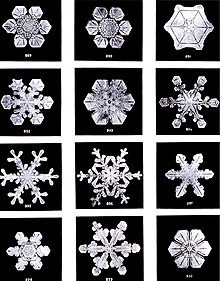
To crystallography
In addition to the astronomical investigations, Kepler wrote an essay on the formation of snow crystals. He discovered that natural forces - not just in snowflakes - cause regular geometric structures to grow. Specifically, he noticed that each snowflake is a unique structure, but on the other hand it is six-pointed. Kepler's hypotheses about the self-structuring of crystals and other natural geometric shapes were developed in a Neoplatonic tradition that had been further developed by Giordano Bruno. Kepler adopted the minimum concept from Giordano Bruno, as he had developed it in the Articuli adversus mathematicos in 1588. In the articuli there are drawings of the square and hexagonal packing as in Kepler's De nive sexangula 1611. Bruno's “De triplici minimo et mensura” from 1591 also contain such drawings with corresponding explanations.
Kepler developed hypotheses about the maximum density of spherical packings , which were used in modern times, among other things, in crystallography and in coding theory , a branch of communications engineering. Kepler suggested that the densest way of stacking spheres was to arrange them in a pyramid shape. Mathematicians tried to prove this in vain for 400 years. On August 8, 1998, the mathematician Thomas Hales announced a proof for Kepler's conjecture . Due to the complexity of the computer evidence, a final review is still pending despite years of efforts by respected experts.
Mathematical work
The idea of logarithmic arithmetic can be found very early (1484) with the French Nicolas Chuquet and then, somewhat further developed, with Michael Stifel (1486–1567) in his Arithmetica integra, which appeared in Nuremberg in 1544 . Practical calculation with logarithms was only possible after the invention of the decimal fraction (around 1600). The Swiss mathematician Jost Bürgi (1552–1632) was heavily involved in the invention of the decimal fractions and their symbolism . He also calculated the log table between 1603 and 1611. Since he did not publish them until 1620 under the title "Arithmetic and Geometric Progresstabuln", despite repeated requests from Johannes Kepler, with whom he worked in Prague, the Scottish Lord John Napier (also Neper ) (1550-1617) got ahead of him. After Kepler had realized what simplification the new calculation method brought with it for the extensive and time-consuming astronomical calculation work, he did everything in his power to popularize the method and make it accessible to a wide range of interested parties. However, he did not adopt Napier's new method as it was: namely, without any information from Napier as to how his figures had come about, so that the tables looked dubious and many scientists were reluctant to use them. To get rid of this obstacle, in 1611 Kepler wrote an explanation of the logarithm principle that went far beyond Napier and completely revised the tables. Philip III von Hessen-Butzbach had Johannes Kepler's Chilias logarithmorum printed in Marburg in 1624 .
As a mathematician, Kepler distinguished himself through his treatment of the general theory of polygons and polyhedra. He discovered several previously unknown spatial structures and constructed them from scratch, including the regular star quadrangle. Johannes Kepler also gave the definition of the antiprism .
In 1615 he developed the so-called Kepler barrel rule named after him , a method for the numerical integration of bodies of revolution .

Technical invention
Another casual job, which Kepler was inspired to do through conversations with a mine owner, led to an important but little appreciated invention. It was about the development of a pump with which water should be lifted out of mine tunnels. After unsuccessful experiments, Kepler came up with the idea of using a crank to drive two “shafts with six grooves each”, that is, gear wheels with rounded corners, so that the wheel cavities carried the water upwards. He had invented a valveless and therefore almost maintenance-free gear pump , which is now installed in a basically similar form in car engines as an oil pump.
Tabulae Rudolfinae
Towards the end of his turbulent life, Johannes Kepler published his last major work in Ulm in 1627 , the Tabulae Rudolfinae ( Rudolfinische Tafeln ). It evaluated the records of Tycho Brahe and described the positions of the planets with unprecedented accuracy. The mean errors were reduced to about 1/30 of the previous values. These planetary tables as well as the celestial mechanical laws presented in the epitome formed the most convincing argumentation aid of the contemporary heliocentrics and later served Isaac Newton as the basis for deriving the theory of gravity .
Somnium
In 1608 Kepler wrote a story called Somnium ("The Dream"), which describes a journey to the moon as realistically as possible at that time. One can Somnium one of the first science fiction - stories call. The work was not published posthumously until 1634. The story of how it came about, however, began four decades earlier: in 1593, when Kepler was a student in Tübingen, he had chosen as the subject of one of the required disputations, how the processes in the firmament would look like on the moon. His goal at the time was to show a parallelism: How we do not feel the rotation of the earth and its movement around the sun, but see the moon moving, a lunar observer could believe that the moon stands still in space and the earth rotates.
Now Kepler wanted to popularize the Copernican view of the world, which he had further developed, with fictitious astronomical observations from the moon; he wanted to try to dissuade the reader from the opinion that the earth would continue to be the center of everything human and divine. He chose the report of a space-traveling spirit as a fairytale framework. The narrating author falls asleep and dreams of a trip to the moon, which is abruptly interrupted by a rain shower in the morning. At that time it was already clear to Kepler that a strong force is required to overcome earthly gravity, like a shot, that a person is exposed to great forces and then falls into weightlessness. He imagined great differences in temperature on the moon, heat during the lunar day and ice and storms during the lunar night. He imagined animals on the moon that had adapted to the inhospitable living conditions.
The fairytale story was published posthumously by his son Ludwig in 1634 and was only partially translated into German in a journal by Edmund Reitlinger in 1871 and as a monograph by Ludwig Günther in 1898 . A complete translation by Hans Bungarten was only published in 2011; ed. and commented on in essays by Beatrix Langner .
Mysticism, astrology and science
At the beginning of Kepler's considerations on the planetary orbits was "enlightenment", the distances of the five planets from the sun correspond exactly to the inscribed and circumscribed spheres of the five platonic solids . When he found extensive mathematical agreement, he was certain that he had revealed the structure (the “architecture”) of space by means of mathematics and observation.
When Kepler observed the supernova 1604 in 1604 , he also saw Providence at work in it: He not only related it to the conjunction of Jupiter and Saturn (1603) and assumed that the new star was triggered by this. He claimed that the same thing happened when the star of Bethlehem appeared : this too had become visible as a result of a large planetary conjunction (first scientific theory of the star of Bethlehem). In the same way the second coming of the Lord is now (1604) not far off.
His work De fundamentis… from 1601 already shows his precise knowledge of astrology . This remained an essential part of his natural-philosophical occupation until the end of his life.
A researcher who made such “dark” doctrines the basis of his scientific investigations must appear dodgy to a rationalist like Galileo . He often exchanged letters with Galileo, but he did not think much of Kepler's "remote powers" and esoteric "harmonies". So the relationship between the two - despite some professional similarities - was rather tense, which is particularly evident in Kepler's simultaneous correspondence with Matthias Bernegger .
In the 17th century, however, Kepler found himself in good company: Isaac Newton showed a keen interest in qualitative natural philosophy (including alchemy ) from his student days until he was old, and so came to his decisive reflections on the effects of gravity on the masses.
Mysterium Cosmographicum
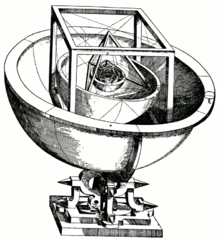
Kepler discovered the planetary laws while trying to accomplish Pythagoras' goal of finding the harmony of the celestial spheres. From his cosmological point of view, it was no accident that the number of regular polyhedra was one less than the number of known planets. He tried to prove that the distances between the planets and the sun are given by spheres within regular polyhedra.
In his book Mysterium Cosmographicum (Das Weltgeheimnis), published in 1596, Kepler attempted to relate the orbits of the then known five planets Mercury , Venus , Mars , Jupiter and Saturn to the surface of the five Platonic solids. He imagined the orbit of Saturn as a great circle on a sphere - not yet an ellipse - that encloses a cube ( hexahedron ). The cube in turn encloses a sphere, which is supposed to describe the orbit of Jupiter (see illustration). This sphere in turn encloses a tetrahedron that envelops the Martian sphere. After Kepler's discovery of the first law named after him - but at the latest after the discovery of more distant planets - this work was only of historical interest.
In his work Harmonice mundi (World Harmony), published in 1619, as in the Mysterium Cosmographicum, he established a connection between the Platonic solids and the classical conception of the elements . The tetrahedron was the shape of fire, the octahedron the symbol of the air, the cube that of the earth, the icosahedron symbolized the water and the dodecahedron stood for the cosmos as a whole or the ether. There is evidence that this comparison is of ancient origin, as Plato explains of a certain Timaeus de Locri, who imagined the universe as surrounded by a gigantic dodecahedron, while the other four bodies were the "elements" of fire, air, and earth and depict the water. To Kepler's disappointment, all of his attempts to arrange the orbits of the planets within a set of polyhedra failed.
His greatest achievement was the discovery that the planets move in ellipses rather than circles. This discovery was a direct consequence of his failed attempt to arrange the planetary orbits in polyhedra. Kepler's willingness to dismiss his most cherished theory in the face of closely observable evidence testifies to his very modern approach to scientific research. It was also a great advance that Kepler tried to trace planetary motion back to a force similar to magnetism, the anima motrix . As he believed, this power emanates from the sun. Although he did not discover gravity, he seems to have been the first to try to find an empirical law that explains the motion of both the earth and the celestial bodies.
astrology
Kepler was convinced that certain constellations of celestial bodies can influence humans like the weather. He tried to fathom the connections and wanted to put astrology on a scientific basis. In his publication De Fundamentis Astrologiae Certioribus ("On more reliable foundations of astrology") from 1601, Kepler set out how astrology could be practiced on a secure basis by placing it on new scientific knowledge in connection with the Pythagorean idea of world harmony. This, too, was an affront to his conservative contemporaries, who preferred Ptolemaic astronomy.
Kepler advocated that a certain relationship between heavenly and earthly events can be established. More than 800 horoscopes and birth cards drawn by Kepler have been preserved. Some concern himself or his family with unflattering remarks. As part of his job as a landscape mathematician in Graz, Kepler made a forecast for 1595 in which he predicted severe uprisings, the Turkish invasion and bitter cold. All of this occurred and earned him the approval of his contemporaries.
In a pamphlet from 1610, Kepler warned theologians, physicians and philosophers "in the case of cheap rejection of the stargazing superstition that the child should be thrown out with the bath water". He despised astrologers who were subservient to the taste of the common man, without knowledge of abstract and general laws. However, he saw it as a legitimate way of forecasting to supplement his meager income. But it would be wrong to dismiss Kepler's astrological interests as purely commercially motivated. Historian John David North said: "Had he not been an astrologer, he would very likely have failed in the task of developing his planetary astronomy as we know it today."
Kepler Wallenstein had already drawn up a horoscope in 1608. It has been preserved and contains, among other things, a character image that is not exactly flattering for Wallenstein. As a consolation, Kepler adds: "But it is the best thing about this birth that Jupiter follows it and gives hope that with a ripe old age most of the vices will be worn away and so this nature of his will be able to do high, important things." Wallenstein was barely 25 years old when he received this first horoscope interpretation. He has checked and annotated them many times over the years.
In 1624, Wallenstein again asked Kepler, through Lieutenant Colonel Gerard von Taxis, to give a second interpretation after changing the birth horoscope calculation. Wallenstein was more astrological than Kepler. It was important to him to find out the course of his fate in advance. Kepler was to tell him what luck and misfortune would happen to him each year, how long the war would last, whether he would die at home or far away, who his hidden and public enemies were.
In January 1625, Kepler complied with the request and subjected Wallenstein's first horoscope to a thorough revision. In his second horoscope report, he emphasized that he wrote this as a philosopher, that is, as a sober thinking person and not out of the mood of folk astrology, which is caught in superstition. He resolutely defended himself against Wallenstein's wish to find out the fate in advance, down to the details and with precise timing: “[...] and just wants to have everything from heaven alone, [...], that really never happened went straight to the school, and has never really brushed the light of reason that God lit up; [...]. ”The report is pervaded by warnings against the astrological fatalism. It is a single underpinning of Kepler's view: “The stars do not force, they only incline.” Kepler gave human arbitrariness the possibility of breaking through heavenly constraints and deviating from the astrologically mapped out path. “Heaven almost never works according to him, but the newborn and others with whom he has to deal do a lot and start a lot out of free will, which they could have omitted and which they would not be compelled to do by heaven. “He unequivocally rejected Wallenstein's request to derive concrete details such as the future cause of death or“ whether he would die in the frembdt ”from the horoscope. “When the guessing is directed towards yes and no, then one hits half the part safely and half the part too. You keep the meeting [...], but you forget the story because it is nothing special, so the astrologus remains honored. "
In 1628, when Kepler knew neither in nor out, Wallenstein reappeared. Although he already had the Italian Giovanni Battista Seni as court astrologer, with Ferdinand II's approval he offered Kepler to join his service as an advisor.
Appreciations

Since Kepler stayed in Linz for some time, the university there was named Johannes Kepler University in his honor in 1975 . The observatories in Weil der Stadt, Graz, Steinberg bei Graz and Linz were also given the name Kepler Observatory. The astronomical station Johannes Kepler , the first school observatory in the GDR in the Kanena district of Halle (Saale) was named after him, as was Keplergasse and Keplerplatz in Vienna ; in Graz the Keplerstraße - opened continuously in 1875 - the Mur Bridge to the east and - after the street - the Keplergymnasium in the building from 1900, further in Regensburg the Keplerstraße, where his house is still standing today. Schools and streets in countless other cities bear his name. As of 2016, the three public hospitals in Linz will be part of the Kepler University Hospital .
In his hometown Weil der Stadt, a memorial was erected in his honor in 1870, on which various scenes from his life are depicted. The Kepler Monument is located in Regensburg .
At his place of work in Prague, a high school is named after Kepler. There is also a joint memorial between Kepler and Tycho Brahe.
In 1963, a monument was erected in the Graz city park , which, in addition to its bust, shows the three planetary laws, which are defined by an ellipse with twelve sectors of the same area - i.e. H. about one per month - to be illustrated. In 1994, 400 years after Kepler came to Graz, a larger exhibition was organized at the Keplergymnasium. The museum space for Johannes Kepler remained in the long run, showing lesser-known aspects of him: harmony, geometry, astrology, mysticism. This adventure space in the basement has a walk-in, internally mirrored icosahedron , is aimed particularly at young people and contrasts with the purely scientifically oriented observatory on the roof of the house.
In addition, the following were named after Kepler: a mountain range in the Fiordland National Park on the South Island of New Zealand and a Great Walk in it as well as an ultramarathon on this track, a large lunar crater with a bright ray system, a Martian crater , the asteroid (1134) Kepler , the NASA space telescope Kepler , the 2662 exoplanets and their stars discovered with it, and ESA's second Automated Transfer Vehicle .
The plant genus Keppleria Mart is also named after Kepler . ex Endl. from the palm family (Arecaceae).
Paul Hindemith created a musical monument for him with his opera Die Harmonie der Welt, completed in 1957 . The opera Kepler by Philip Glass , a work commissioned for Linz, the European Capital of Culture 2009 , premiered on September 20, 2009 in Linz . A bust of Kepler was added to the Walhalla memorial in Bavaria in 1842 . On October 21, 2009, the Czech National Bank issued a 200 kroner commemorative coin in his honor. A graphics processor micro - architecture from Nvidia and version 4.3 of the Eclipse development environment bear his name.
The Evangelical Church in Germany commemorates Kepler with a day of remembrance in the Evangelical Name Calendar on November 15th .
factories
Collected works Max Caspar , Walther von Dyck (eds.): Beck, Munich 1938 ff. (KGW for short)
- Volume I: Johannes Kepler: Mysterium cosmographicum. De stella nova . Edited by Max Caspar. In: German Research Foundation and Bavarian Academy of Sciences (Hrsg.): Johannes Kepler - Gesammelte Werke . tape I . CH Beck, Munich 1993, ISBN 3-406-01639-1 ( BAdW KGW I [PDF; accessed on January 3, 2020] first edition: 1938).
- Volume II: Astronomiae pars optica. Ad Vitellionem Paralipomena. Edited by Franz Hammer , Munich 1939.
- Volume III: Astronomia nova aitiologetos seu Physica coelestis. Edited by Max Caspar, Munich 1938.
- Volume IV: Smaller Writings. Dioptrice. Edited by Max Caspar, Munich 1941.
- Volume V: Chronological Writings. Edited by Franz Hammer, Munich 1953.
- Volume VI: Harmonices Mundi libri V. Ed. Max Caspar, Munich 1940/1990, ISBN 3-406-01648-0 .
- Volume VII: Epitome Astronomiae Copernicanae. Edited by Max Caspar, Munich 1953.
- Volume VIII: Mysterium cosmographicum. De cometis. Tychonis hyperaspites. Edited by Franz Hammer, Munich 1963.
- Volume IX: Mathematical Writings. Edited by Franz Hammer, Munich 1955/2000, ISBN 3-406-01655-3 .
- Volume X: Tabulae Rudolphinae. Edited by Franz Hammer, Munich 1969.
- Volume XI, 1: Ephemerides novae motuum coelestium. Edited by Volker Bialas, Munich 1983, ISBN 3-406-01659-6 .
- Volume XI, 2: Calendaria et Prognostica. Astronomica minora. Somnium seu Astronomia lunaris. Edited by Volker Bialas, Helmuth Grössing, Munich 1993, ISBN 3-406-37511-1 .
- Volume XII: Theologica. Witch trial. Poems. Tacitus translation. Edited by Jürgen Hübner, Helmuth Grössing, Munich 1990, ISBN 3-406-01660-X .
- Volume XIII: Letters 1590-1599. Edited by Max Caspar, Munich 1945.
- Volume XIV: Letters 1599-1603. Edited by Max Caspar, Munich 1949.
- Volume XV: Letters 1604-1607. Edited by Max Caspar, Munich 1951.
- Volume XVI: Letters 1607-1611. Edited by Max Caspar, Munich 1954.
- Volume XVII: Letters 1612-1620. Edited by Max Caspar, Munich 1955.
- Volume XVIII: Letters 1620-1630. Edited by Max Caspar, Munich 1959.
- Volume XIX: Documents on Life and Work. Ed. Martha List, Munich 1975, ISBN 3-406-01674-X .
- Volume XX, 1: Manuscripta astronomica I. Ed. Volker Bialas, Munich 1988. ISBN 3-406-31501-1 .
- Volume XX, 2: Manuscripta astronomica II. Ed. Volker Bialas, Munich 1998. ISBN 3-406-40592-4 .
- Volume XXI, 1: Manuscripta astronomica III. Eds. Volker Bialas, Friederike Boockmann, Eberhard Knobloch [u. a.], Munich 2002, ISBN 3-406-47427-6 .
- Volume XXI, 2.1: Johannes Kepler: Manuscripta harmonica, Manuscripta chronologica . Edited by Volker Bialas, Friedrich Seck. In: Kepler Commission of the Bavarian Academy of Sciences (ed.): Johannes Kepler - Gesammelte Werke . XXI, 2.1. CH Beck, Munich 2009, ISBN 978-3-406-57871-7 ( BAdW KGW Volume XXI, 2.1 [PDF; accessed on January 3, 2020]).
- Volume XXI, 2.2: Johannes Kepler: Manuscripta astrologica, Manuscripta pneumatica . Edited by Friederike Boockmann, Daniel A. Di Liscia. In: Kepler Commission of the Bavarian Academy of Sciences (ed.): Johannes Kepler - Gesammelte Werke . XXI, 2.2. CH Beck, Munich 2009, ISBN 978-3-406-57871-7 ( BAdW KGW Volume XXI, 2.2 [PDF; accessed on January 3, 2020]).
Poems
- All the poems . Edited and commented by Friedrich Seck; Translated by Monika Balzert, Olms, 2nd edition, Hildesheim 2020 (Spudasmata, Volume 180), ISBN 978-3-487-31192-0 .
List of works and references
- Gerhard Dünnhaupt : Johannes Kepler. In: Personal bibliographies on Baroque prints. Vol. 3. Hiersemann, Stuttgart 1991, ISBN 3-7772-9105-6 , pp. 2269-2308.
Individual works (selection)
- Answer by Joannis Keppleri Sae. Cae. Mtis. Mathematici auff D. Helisaei Röslini Medici et Philosophi Discurs / The nature of today / and how things will go in the future. Prague: Sesse, 1609. ( digitized and full text in the German text archive )
- Extract from the ancient fairy tale Kunſt Archimedis and the same new substitution in Latin / regarding the account of the physical figures / fetching vessels and wine barrels / especially the Austrian / ſo and all the others have the proper chic. Explanation and satisfaction of the Austrian Weinbeier Ruthen / and the strange, very easy and nimble use of the country barrels: Extension of this to the foreign area / ſo also to the gun and bullets. Sampt a very useful appendix from the comparison of the traditional weight / Elen / Klaffter / Schuch / Wein- and Traid Maaß / and each other / and with other foreigners / also Old Romans. Linz: self-published; Blanck, 1616. ( digitized version and full text in the German text archive )
- Tertius interveniens. That is / Warning to a number of Theologos, Medicos and Philosophos, especially D. Philippum Feselium, that when the stargazing superstitions are rejected, they / do not pour out the child with the bath / and thereby act ignorantly contrary to their profession: With many highly important ones they never aroused or before discussed philosophical questions adorned / all true lovers of natural secrets to necessary instruction / provided by Johann Kepplern / the Rom. Keys. Your majesty Mathematicum. Franckfurt am Mäyn: Tampach, 1610. ( digitized and full text in the German text archive )
- Nychthēmeron Augustale Joannis Kepleri Impp: Caess: Rudolphi II. Fm & Mathiae I. Mathematici, Prague 1612 ( digitized version )
- Lessons from the H. Sacrament of the Body and Blood of Jesus Christ our Savior, [Prague] 1617 ( digitized version )
- Joannis Keppleri Somnium seu Opus posthumun de astronomia lunari. Accedit Plutarchi libellus De facie quae in orbe lunae apparet. E Graeco Latine redditus a Joanne Kepplero. Facsimile print of the 1634 edition. Edited by Martha List and Walther Gerlach with an afterword. Zeller, Osnabrück 1969. ( Entry on openlibrary.org )
- Kepler's dream of the moon. [Translated and commented] by Ludwig Günther. Teubner, Leipzig 1898. ( Digital new edition Univ. Heidelberg, 2013)
- The dream, or: lunar astronomy. Somnium sive astronomia lunaris. With a guide for moon travelers by Beatrix Langner. Edited by Beatrix Langner. From the neo-Latin niche of Dr. Hans Bungarten, Matthes & Seitz, Berlin 2010, ISBN 978-3-88221-626-4 .
- Contra Ursum. In: La guerre des astronomes. La querelle au sujet de l'origine du système geo-héliocentrique à la fin du XVIe siècle . 2 vols. Edited by Nicholas Jardine and Alain-Philippe Segonds, Paris, Les Belles Lettres, 2008. (Science et humanisme; 9-10). ISBN 978-2-251-34513-0 . ISBN 978-2-251-34512-3
- Mysterium Cosmographicum. (German: Das Weltgeheimnis ) (Reprint available from: Johannes Kepler - What holds the world together in its innermost being. Answers from writings by Johannes Kepler. (Mysterium cosmographicum, Tertius interveniens, Harmonice mundi) in German translation with an introduction, explanations and glossary published by Fritz Krafft . Marixverlag, 2005).
- Harmonice Mundi. (German: Weltharmonik ) Unchanged reprint of the 1939 edition. Translated and introduced by Max Caspar. 7th edition 2006. Oldenbourg Verlag, ISBN 978-3-486-58046-4 (Reprint also available from: Johannes Kepler - What holds the world together inside. Answers from writings by Johannes Kepler. (Mysterium cosmographicum, Tertius interveniens, Harmonice mundi ) in German translation with an introduction, explanations and glossary, edited by Fritz Krafft, Marixverlag, 2005.)
- Harmonice Mundi. (German: Weltharmonik ) III. Book, translated and critically commented by Hilmar Trede, 1st edition 2011. Ugrino-Verlag Henny Jahn, ISBN 978-3-9814459-0-9 (edited by Henny Jahn).
- Dioptrice. (German: Dioptrics or description of the consequences of the recently made invention of telescopes for sight and visible objects. Translated and edited by F. Plehn. 2nd ed. German, Thun and Frankfurt / Main 1997 (Ostwald's Classics of Exact Sciences, Vol. 144) ISBN 3-8171-3144-5 ).
- Tabulae Rudolfinae. (German: The Rudolfinische Tafeln ).
- Astronomia Nova. (German: Neue Astronomie ) (Reprinted by Oldenbourg Verlag, ISBN 978-3-486-55341-3 , also available from: Johannes Kepler: Astronomia Nova: Neue, causally founded astronomy. Ed. And incorporated by Fritz Krafft (Library of lost knowledge) 2005. LVIII, 576 S., Marixverlag, ISBN 3-86539-014-5 ).
- Somnium. (German: The dream ).
- Nova stereometria doliorum vinariorum. (German: New stereometry of the wine barrels ).
- From the secured fundamentals of astrology. (Reprint available under ISBN 3-925100-38-5 ).
- New Astronomy by Johannes Kepler, unaltered reprint of the 1929 edition. Oldenbourg Wissenschaftsverlag, Munich 1990, ISBN 978-3-486-55341-3 .
- Tertius Interveniens. Warning to many opponents of astrology not to throw the child out with the bath water. Introduced and annotated by Jürgen Hamel . German, Frankfurt / Main 2004 (Ostwald's Classics of Exact Sciences, Vol. 295) ISBN 3-8171-3295-6 .
- From the new star in the foot of the serpent-bearer . Translated by Eva and Otto Schönberger and Eberhard Knobloch . Königshausen & Neumann, Würzburg 2006, ISBN 978-3-8260-3139-7 .
- Brief presentation of Copernican astronomy in seven volumes . Translated by Eva and Otto Schönberger and Eberhard Knobloch. Königshausen & Neumann, Würzburg 2009, ISBN 978-3-8260-4202-7 .
- From the true year of Christ's birth . Translated by Eva and Otto Schönberger. Verlag Marie Leidorf, Rahden 2016, ISBN 978-3-8675-7106-7 .
Online editions
- De Stella nova in pede serpentarii . On: Rare Books Collection at the Vienna Observatory . (Electronic facsimile editions of the book collection of the Vienna University Observatory, download PDF).
- Digital copies of works by Kepler at archive.org
- Joannis Kepleri Sae. Cae. Mtis. Mathematici Dioptrice Seu Demonstratio eorum quae visui & visibilibus propter Conspicilla non ita pridem inventa accidunt , 1611, e-book of the University Library Vienna
- Kepler Complete Edition of the Bavarian Academy of Sciences
literature
- Bibliographia Kepleriana. A guide through the printed literature of (and about) Johannes Kepler. On behalf of the Bavarian. Akad. D. Knowledge ed. by Max Caspar, Munich 1936. 2nd edition esp. Martha List, Munich 1968, ISBN 3-406-01685-5 and ISBN 3-406-01684-7 .
- Supplementary volume z. 2nd edition, especially by Jürgen Hamel , Munich 1998, ISBN 3-406-01687-1 and ISBN 3-406-01689-8 .
- Doris Becher-Hedenus: “We all travel an eccentric path.” The German Kepler reception in the 18th century and the Regensburg monument from 1808. Regensburg 2010.
- Volker Bialas : Johannes Kepler. C. H. Beck, Munich 2004, ISBN 3-406-51085-X .
- Max Caspar : Johannes Kepler. Edited by the Kepler Society, Weil der Stadt. 4th edition, supplemented by a complete list of sources. GNT-Verlag, Stuttgart 1995 (reprint of the 3rd edition of 1958), ISBN 978-3-928186-28-5 .
- Jörg Ehtreiber, Adolf Hohenester, Gerhard Rath: The cosmic dreamer. Leykam Verlag, Graz 1994, online .
- Günter Doebel: Johannes Kepler - He changed the worldview. Styria, Graz / Vienna / Cologne 1996, ISBN 3-222-11457-9 .
- Walther Gerlach , Martha List: Johannes Kepler. 2nd edition, Piper, Munich 1980, ISBN 3-492-00501-2 .
- Johannes Hemleben : Johannes Kepler. Rowohlt Taschenbuch Verlag, 1995, ISBN 978-3-499-50183-8 .
- Marie-Luise Heuser : Kepler's theory of the self-structuring of snowflakes against the background of Neoplatonic philosophy of mathematics. In: self-organization. Vol. 3, ed. v. Uwe Niedersen. Duncker & Humblot, Berlin 1992, ISBN 3-428-07515-3 , pp. 237-258.
- Marie-Luise Heuser: Transterrestrik in the Renaissance. Nikolaus von Kues, Giordano Bruno and Johannes Kepler. In: M. Schetsche, M. Engelbrecht (Ed.): People and extraterrestrials. Cultural studies look at an adventurous relationship. transcript, Bielefeld 2008, pp. 55-79.
- Johannes Hoppe: Johannes Kepler. Teubner, Leipzig 1976.
- Jürgen Hübner: Johannes Kepler: Astronomy as theology of creation , in: European History Online , ed. from the Institute for European History (Mainz) , 2010, accessed on March 25, 2021 ( pdf ).
- Arthur Koestler : The Night Walkers. Bern 1959.
- Alexandre Koyré : La révolution astronomique. Copernic, Kepler, Borelli. Hermann, Paris 1961 (Histoire de la pensée; 3).
- Fritz Krafft : orbis (sphaera), circulus, via, iter, orbita - for terminological identification of the most important paradigm shift in astronomy by Johannes Kepler. In: Contributions to the history of astronomy. Volume 11, (Acta Historica Astronomiae, Vol. 43), pp. 25-99, bibcode : 2011AcHA ... 43 ... 25K .
- Mechthild Lemcke: Johannes Kepler. 2nd Edition. Rowohlt, Reinbek 2002, ISBN 3-499-50529-0 .
- Martha List: Kep (p) ler, Johannes. In: New German Biography (NDB). Volume 11, Duncker & Humblot, Berlin 1977, ISBN 3-428-00192-3 , pp. 494-508 ( digitized version ).
- Anna Maria Lombardi: Johannes Kepler - Insights into heavenly harmony. Spectrum d. Science, Weinheim 2000.
- Thomas de Padova: The world secret. Kepler, Galileo and the measurement of the sky. Piper Verlag, Munich 2009, ISBN 3-492-05172-3 ; 352 pages.
- Thomas Posch: Johannes Kepler. The discovery of world harmony. Scientific Book Society, Darmstadt 2017, ISBN 978-3-8062-3452-7 .
- Frank Reiniger: Kepler / Keppler, Johannes. In: Biographisch-Bibliographisches Kirchenlexikon (BBKL). Volume 3, Bautz, Herzberg 1992, ISBN 3-88309-035-2 , Sp. 1366-1379.
- Nikolaus Richter : Kepler and the comets. In: Science and Progress . Volume 21, December 1971, pp. 536-539
- Laetitia Rimpau: Visions of New Science. On the dialogical poetry by Dante Alighieri and Johannes Kepler, Universitätsverlag Winter, Heidelberg 2021. ISBN 978-3-8253-4685-0
- Ulinka Rublack: The Astronomer and the Witch. Johannes Kepler and his time. Klett-Cotta, Stuttgart 2018, ISBN 978-3-608-98126-1 .
- Wolfgang Schütz: Kepler and posterity. Book accompanying the exhibition in the Stadtmuseum Weil der Stadt. Edited by the Heimatverein Weil der Stadt. 2nd, improved and enlarged edition. 2017, ISBN 978-3-00-056424-6 .
- Gérard Simon: Kepler astronome astrologue. Gallimard, Paris 1979 ( Bibliothèque des sciences humaines ), ISBN 2-07-029971-6 .
- Berthold Sutter: The witch trial against Katharina Kepler. Edited by the Kepler Society, Weil der Stadt 1979.
- Berthold Sutter: Johannes Kepler and Graz. In the field of tension between intellectual progress and politics. Leykam Verlag, Graz 1975, ISBN 3-7011-7049-5 .
- Wieslaw Urban: The Kepler Reception in German Literature . In: Negotiations of the Historical Association for Upper Palatinate and Regensburg , Volume 153, Regensburg 2013, pp. 171–205, ISSN 0342-2518
- Carl Friedrich von Weizsäcker : Copernicus, Kepler, Galilei. In: Carl Friedrich von Weizsäcker: The scope of science . First volume: Creation and the origin of the world. The story of two concepts. Hirzel, Stuttgart 1964, pp. 96-117.
- Arnulf Zitelmann : Kepler's worlds. Johannes Kepler - A picture of life. OLZOG Edition, Lau Verlag & Handel KG, Reinbek near Hamburg 2016. ISBN 978-3-95768-171-3 .
Fiction:
- Thomas Hoeth : Falling to Heaven. Silberburg-Verlag, Tübingen 2012.
- Bertold Keppelmüller : The Law of the Stars. Johannes Keppler's novel of life. People's Association of Book Lovers. Wegweiser-Verlag GmbH, Berlin (1943), 295 pp.
- Olaf Saile : Kepler. Novel of a turning point. Fleischhauer & Spohn, Stuttgart 1938.
- Rosemarie Schuder : The witch's son - In the devil's mill. Rütten & Loening, Berlin 1968.
- Wilhelm and Helga Strube: Kepler and the General. New life, Berlin 1985.
- Johannes Tralow : Kepler and the Kaiser. Verlag der Nation, Berlin 1961.
Movie
In 1974 the biographical feature film Johannes Kepler (directed by Frank Vogel ) was released in the GDR . The film puts Kepler's time in Linz in the foreground and focuses on the rescue of the mother who was to be convicted in a witch trial.
In 2015 arte broadcast the film L'Oeil de l'astronome in the German version Johannes Kepler or Der Blick zu den Sternen.
In 2020 arte broadcast the docudrama Johannes Kepler, der Himmelsstürmer by Susanne Utzt (book) and Christian Twente (director)
Web links
- Solar system simulator of the Kuffner observatory
- Literature by and about Johannes Kepler in the catalog of the German National Library
- Works by and about Johannes Kepler in the German Digital Library
- Publications by and about Johannes Kepler in VD 16 .
- Publications by and about Johannes Kepler in VD 17 .
- Johannes Kepler in the Internet Speculative Fiction Database (English)
- Works by and about Johannes Kepler at Open Library
- Digitized prints by Johannes Kepler in the catalog of the Herzog August Library
- Facsimile of the Ioannis Keppleri Harmonices Mundi Libri V
Biographical:
- Entry. In: Johann Heinrich Zedler : Large complete universal lexicon of all sciences and arts . Volume 15, Leipzig 1737, sheet 245. (Keplerus, Joann)
- Kepler biography. ( Memento of May 4, 2012 in the Internet Archive ). On the side of the Johannes-Kepler-Gymnasium, Weil.
Materials:
- Kepler, Johannes - list of links (German / English)
- Kepler Museum Because of the city
- Kepler Memorial House Regensburg
Individual evidence
- ^ Kepler Society V .: Kepler as a landscape mathematician in Graz (1594–1600).
- ↑ Volker Bialas: From the heavenly myth to the world law. Ibera-Verlag, Vienna 1998, p. 278.
- ^ Albrecht von Haller : Elementa physiologiae corporis humani. 8 volumes. Lausanne 1757–1763 / Bern 1764–1766, here: Volume 2 (1760), p. 259 (“Primus, ni fallor, […] Keplerus pulsuum in dato tempore numerum definire suscepit […]”).
- ↑ Werner Friedrich Kümmel : The pulse and the problem of time measurement in the history of medicine. In: Medizinhistorisches Journal. Volume 9, 1974, pp. 1-22, here: pp. 5 f.
- ↑ Erich Meyer: In the footsteps of Johannes Kepler . tredition, Hamburg 2021, p. 60 ff .
- ↑ Sa "Where Kepler lived when he found his third law" in "Der Sternenbote", 743 / 2018-6, S, 90f
- ↑ orf.at: Kepler's home address discovered in Linz . Article dated May 8, 2018, accessed May 8, 2018.
- ↑ See: Ulinka Rublack : The Astronomer and the Witch. Johannes Kepler and his time. Klett-Cotta, Stuttgart 2018, ISBN 978-3-608-98126-1 .
- ↑ Volker Bialas: Johannes Kepler. C. H. Beck, Munich 2004, p. 37.
- ^ Johannes Kepler Evangelical Museum Upper Austria
- ^ Karl Bauer: Regensburg. Art, culture and everyday history. MZ Buchverlag, Regensburg 2014, ISBN 978-3-86646-300-4 . Pp. 240-242.
- ↑ Johannes Kepler. Retrieved February 5, 2021 .
- ^ Karl Bauer: Regensburg art, culture and everyday history . 6th edition. MZ-Buchverlag in H. Gietl Verlag & Publication Service GmbH, Regenstauf 2014, ISBN 978-3-86646-300-4 , p. 242 f .
- ↑ Paolo Rossi: The birth of modern science in Europe. Translated. Munich 1997, p. 174 f.
- ↑ Hans-Dieter Dyroff: Print of the Astronomia Nova by Johannes Kepler: Gotthard Vögelin: publisher, printer, bookseller . Diss. Univ. Mainz 1962. 1962 ( Abstract , Ub Uni Heidelberg). Abstract ( Memento from May 28, 2012 in the Internet Archive )
- ↑ 400 years of scientific optics (Johannes Kepler's "Ad Vitellionem paralipomena quibus astronomiae pars optica" 1604). ( Memento of July 9, 2017 in the Internet Archive ). At: mathematik.de.
- ^ Marie-Luise Heuser-Keßler: Maximum and Minimum. On Bruno's foundation of geometry in the Articuli adversus mathematicos and its further application in Kepler's New Year's gift or Vom hexagonal Schnee . In: Klaus Heipcke et al. (Ed.): The Frankfurt writings of Giordano Brunos and their requirements . Acta humaniora, Weinheim 1991, ISBN 3-527-17760-4 , pp. 181-197 .
- ^ Marie-Luise Heuser-Keßler: Kepler's theory of the self-structuring of snowflakes against the background of Neoplatonic philosophy of mathematics . In: Uwe Niedersen (Ed.): Self-organization . tape 3 . Duncker & Humblot, Berlin 1992, ISBN 3-428-07515-3 , pp. 237-258 .
- ^ Marie-Luise Heuser : Transterrestrik in the Renaissance. Nikolaus von Kues, Giordano Bruno and Johannes Kepler. In: M. Schetsche, M. Engelbrecht (Ed.): People and extraterrestrials. Cultural studies look at an adventurous relationship. Bielefeld (Transcript-Verlag) 2008, pp. 55-79.
- ↑ Max E. Lippitsch: Mysterium cosmographicum: Catalog for Styrian exhibitions in the international year of astronomy 2009. P. 292 f.
- ↑ Edward Rosen (Ed.): Kepler's Somnium: The Dream, Or Posthumous Work on Lunar Astronomy. Courier Corporation, 1967, p. 242.
- ↑ Kepler's dream of the moon. Translated and commented by Ludwig Günther, Leipzig 1898, digital new edition (HeiDOK). PDF; 5.2 MB (200 pages).
- ↑ Edward Rosen (Ed.): Kepler's Somnium: The Dream, Or Posthumous Work on Lunar Astronomy. Courier Corporation, 1967, p. IX.
- ↑ publisher's website ; FAZ article , accessed on January 17, 2015.
- ^ Tertius Interveniens. This is / warning to a number of theologians, medicos and philosophers, especially D. Philippum Feselium, that if the stargazing superstitions are rejected, they / do not pour out the child with the bath / and thereby act ignorantly contrary to their profession. Godtfriedt Tampachs, Franckfurt am Mayn 1610 ( at the WDB )
- ↑ Collected Works; Volume XXI, 2.2 ; P. 460
- ↑ Collected Works; Volume XXI, 2.2 ; Pp. 461, 462
- ^ School observatory BRG Kepler Graz
- ↑ Johannes Kepler Volkssternwarte (Steinberg bei) Graz , opened in 1983 by the Styrian Astronomical Association.
- ↑ 1.2 History of the BRG Kepler at a glance anderslernen.net, entries up to 2004/2005, accessed on September 27, 2016.
- ^ Museum room on Johannes Kepler, Keplergymnasium Graz, accessed on November 21, 2013.
- ↑ Dennis Overbye: Kepler, the Little NASA Spacecraft That Could, No Longer Can . New York Times. Retrieved October 31, 2018.
- ↑ Lotte Burkhardt: Directory of eponymous plant names . Extended Edition. Botanic Garden and Botanical Museum Berlin, Free University Berlin Berlin 2018. [1]
- ↑ Sean Hollister: NVIDIA reveals Fermi's successor: Kepler at 28nm in 2011, Maxwell in 2013. Engadget, September 21, 2010, accessed November 14, 2010 .
- ↑ Alexander Neumann: 71 projects at Eclipse Kepler. Heise online, June 26, 2013, accessed on May 27, 2019 .
- ↑ Johannes Kepler in the Ecumenical Lexicon of Saints
- ↑ Johannes Kepler. GDR 1973/1974, feature film. Description at Filmportal.de. Retrieved April 30, 2011.
-
↑ Johannes Kepler or The View to the Stars. ( Memento from August 11, 2015 in the Internet Archive ). At: arte.tv. (The video is no longer available).
See also: L'Œil de l'astronome. At: fr.wikipedia.org. - ↑ Johannes Kepler, the sky-stormer. Retrieved August 11, 2020 .
| personal data | |
|---|---|
| SURNAME | Kepler, Johannes |
| ALTERNATIVE NAMES | Keplerus, Ioannes (Latin); Keppler, Johannes |
| BRIEF DESCRIPTION | German natural philosopher, mathematician, astronomer, astrologer, optician and Protestant theologian |
| BIRTH DATE | December 27, 1571 |
| PLACE OF BIRTH | Because of the city |
| DATE OF DEATH | November 15, 1630 |
| PLACE OF DEATH | regensburg |


